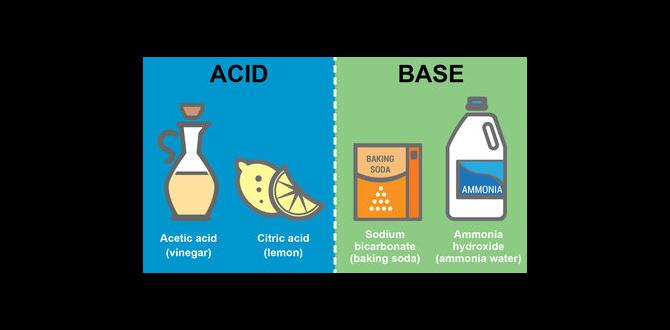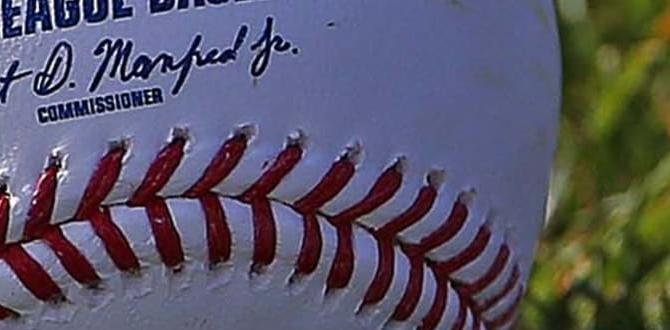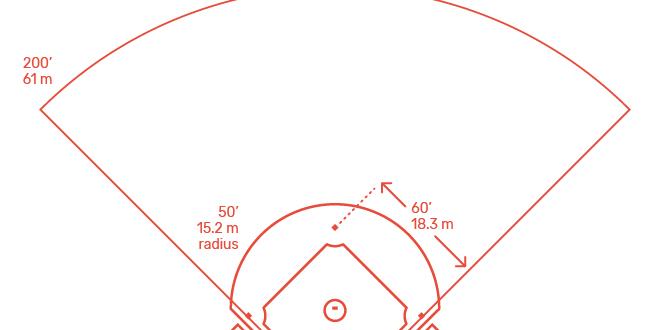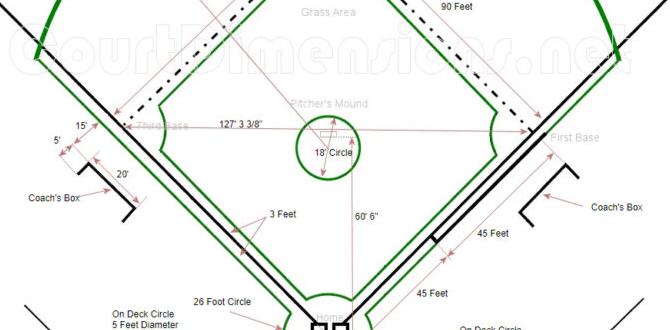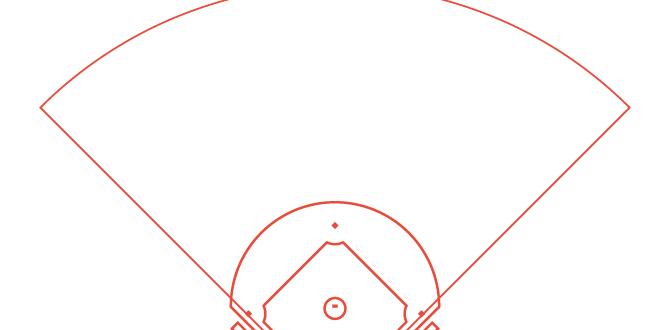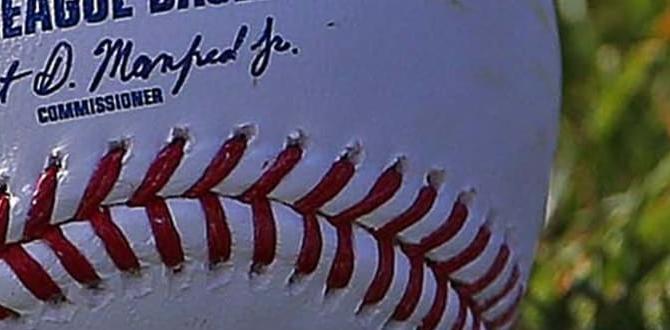Have you ever wondered how the dimensions for a baseball field are decided? Baseball fields vary in size, but do you know why? Each measurement plays a big role in how the game is played. Imagine running from home plate to first base. It’s 90 feet! That’s just one part of the whole field.
Most baseball fans don’t think about the shape and size of the field. But these dimensions influence the action in every game. Did you know that different stadiums can have different outfield distances? Some teams even have quirky features like a short right field. This can change the way players hit and catch the ball.
In this article, we will explore the exciting world of baseball field dimensions. You’ll learn how these measurements make the game fun and challenging. So, grab your glove and let’s step onto the field of knowledge!
Essential Dimensions For Baseball Field Layouts Explained
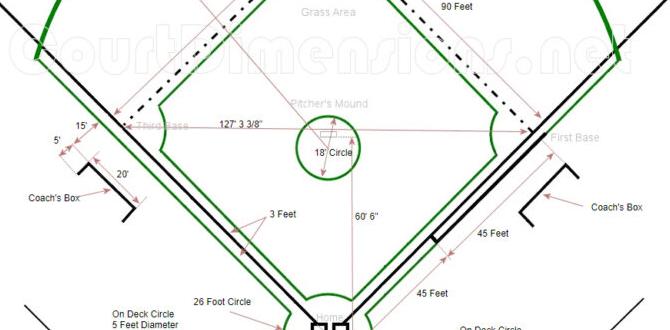
Dimensions for Baseball Field
A baseball field has specific dimensions that make the game exciting. The infield is a diamond shape with 90 feet between bases. The pitcher’s mound is 60 feet, 6 inches from home plate. Did you know the outfield fences can vary? They often range from 300 to 400 feet from home plate! Understanding these dimensions helps players know where to run and how to position themselves. Curious about how these measurements affect gameplay?Infield Dimensions
Detailed measurements for base paths and pitcher’s mound. Variations in infield dimensions for different levels of play (Little League, High School, College, MLB).The infield is where the magic happens on a baseball field. It has clear measurements to keep the game fair and fun. The distance between bases is 90 feet in Major League Baseball (MLB), making it a sprint for players. In Little League, it’s shorter at just 60 feet. The pitcher’s mound is also different; in MLB, it’s 60 feet, 6 inches from home plate, while Little League has it at 46 feet. Here’s a quick look:
| Level | Base Path | Pitcher’s Mound |
|---|---|---|
| Little League | 60 feet | 46 feet |
| High School | 90 feet | 60 feet, 6 inches |
| College | 90 feet | 60 feet, 6 inches |
| MLB | 90 feet | 60 feet, 6 inches |
These sizes can change how the game feels. Just imagine a Little League player trying to outrun a cheetah! Keep in mind, all these dimensions help make baseball exciting at every level!
Outfield Dimensions
Standard outfield fence distances and configurations. Differences between professional and amateur outfield dimensions.Baseball fields are unique in their size. The outfield fences can vary greatly, giving each park its own character. Most professional leagues set the outfield distance around 300 feet down the lines and 400 feet to center field. Meanwhile, amateur fields often range from 200 to 350 feet. It’s like comparing a toddler’s swing to a pro’s! Here’s a quick look at different dimensions:
| Level | Left/Right Field | Center Field |
|---|---|---|
| Professional | 300-350 ft | 400 ft |
| Amateur | 200-300 ft | 250-350 ft |
Each field tells a story. Professional players swing for the fences, while rookie leagues keep it a bit more cozy. Who knew a little distance could spark such big dreams?
Baseball Field Orientation
Recommended orientation for optimal sunlight exposure. How field orientation impacts gameplay and visibility.Choosing the right orientation for a baseball field is vital. Positioning the field north to south is best. This setup protects players from direct sunlight during games. It helps everyone see the ball clearly. Good visibility creates fair play and fun. Also, it can improve the quality of the game.
What is the recommended orientation for a baseball field?
The best orientation is north to south. This angle reduces sunlight issues during evening games.
Why does field orientation matter?
- Better visibility for players
- Prevents glare from the sun
- Enhances fan experience
Field Surface and Quality Standards
Types of field surfaces (grass, turf) and their dimensions. Maintenance tips to keep the field dimensions accurate and safe.Baseball fields can have two main surfaces: grass or turf. Grass fields feel nice and cozy, like laying on a fluffy cloud (well, almost). Turf fields are like a superhero’s cape—tough and low maintenance. Each surface has its own dimensions and special care tips. Keeping the field shape right is key for players’ safety. A little love goes a long way! Here are some quick maintenance tips:
| Field Surface | Dimensions (In Feet) | Maintenance Tips |
|---|---|---|
| Grass | 90 x 400+ | Mow regularly, water, and aerate the soil. |
| Turf | 90 x 400+ | Rinse, groom, and check seams. |
With the right care, your field will be the crown jewel of the game, keeping everyone safe and happy!
Foul Lines and Home Plate Measurement
Explanation of foul lines and their distance from home plate. Importance of home plate dimensions in relation to the pitcher’s mound.Foul lines are the lines that run from home plate to the outfield fence. They mark the fair and foul territory. The distance from home plate to the foul lines is 90 feet on each side. This helps players know where the ball can be played.
Home plate is also special. Its distance from the pitcher’s mound is 60 feet 6 inches. This measurement is important for the game. It allows pitchers to throw at the right speed while batters stay alert. Without these measurements, the game would be chaotic and unfair.
Why are foul lines important?
Foul lines help players know where to hit the ball. They also keep the game organized.
Key Measurements:
- Foul lines to home plate: 90 feet
- Pitcher’s mound to home plate: 60 feet 6 inches
Adjustments and Customizations in Field Dimensions
Guidelines for modifying field dimensions for different age groups or skill levels. Impact of custom dimensions on player development and safety.Adjusting the size of a baseball field helps young players. For younger kids, smaller bases and shorter pitches work best. This way, they feel more confident. Older players might need larger fields to challenge their skills. Custom dimensions can improve safety too. Players will have less risk of injury with a suitable setup.
- Younger 6-8 years: 60 ft bases, 30 ft pitching distance
- Older 9-12 years: 70 ft bases, 46 ft pitching distance
- Teens 13-15 years: 90 ft bases, 60.5 ft pitching distance
How can field dimensions affect player development?
Custom sizes help players improve skills and stay safe. They allow kids to enjoy the game while learning. Safety is key; the right distance can prevent accidents.
Common Mistakes in Measuring Baseball Field Dimensions
Identification of frequent errors in field layout. Solutions to ensure accuracy in the field construction process.Measuring a baseball field can be tricky. Many people make mistakes with the layout. Common errors include wrong distances and incorrect angles. To fix these issues, check measurements regularly. Use a tape measure or laser tool to ensure accuracy.
- Double-check base distances.
- Mark the pitcher’s mound carefully.
- Ensure the outfield is the right size.
By being careful, you can create a better playing area. Remember, the right measurements make the game more fun!
What are the common errors made in baseball field measurements?
Common errors include wrong base distances, improper pitcher’s mound placement, and inaccurate outfield size.
How can mistakes be avoided when measuring a baseball field?
Regularly check measurements, use proper tools, and educate workers on accurate standards.
Conclusion
In summary, knowing the dimensions of a baseball field is important for players and fans. The bases are 90 feet apart, and the pitcher’s mound is 60 feet 6 inches from home plate. You can visit a local field to see these measurements in action. Understanding these basics makes watching and playing baseball even more fun! Keep exploring baseball!FAQs
Sure! Here Are Five Questions Related To The Dimensions Of A Baseball Field:Sure! A baseball field is shaped like a diamond. The distance from home plate to first base is 90 feet. The outfield goes far beyond the bases. The pitcher’s mound is 60 feet and 6 inches away from home plate. The bases are all the same size: 15 inches square.
Sure! Please provide the question you want me to answer.
What Are The Standard Dimensions Of The Bases On A Baseball Field, And How Far Apart Are They Positioned?The bases on a baseball field are all 15 inches (about 38 centimeters) square. They are placed in a diamond shape. Each base is 90 feet, or 30 yards, apart from the next one. So, you run 90 feet from home plate to first base, and then to second base, and so on.
How Far Is The Pitcher’S Mound From Home Plate In Professional Baseball, And Does This Distance Vary In Other Leagues?The pitcher’s mound is 60 feet and 6 inches away from home plate in professional baseball. This distance is the same for Major League Baseball (MLB). However, in some other leagues, like Little League, the mound can be closer. So, the distance can vary depending on the league you are playing in.
What Is The Recommended Distance From Home Plate To The Outfield Fences In Major League Baseball, And How Can This Vary Among Different Stadiums?In Major League Baseball (MLB), the recommended distance from home plate to the outfield fences is about 325 feet down the foul lines and 400 feet to center field. This means the fences can be closer or farther away depending on the stadium. Some parks have shorter fences, while others have longer ones. Each stadium is unique, making baseball fun and interesting!
What Are The Dimensions Of The Infield And Outfield Areas On A Regulation Baseball Field?The infield area is a square that is 90 feet on each side. The bases are placed at the corners of this square. The outfield is much bigger and is often about 325 to 400 feet from home plate to the outfield fence. So, you see, the infield is really small compared to the outfield!
How Do The Dimensions Of A Youth Baseball Field Differ From Those Of A Professional Baseball Field?Youth baseball fields are smaller than professional ones. The pitching distance is shorter, usually about 46 feet for kids. The bases are closer together, often 60 feet apart. In a big league field, the bases are 90 feet apart. This makes it easier for younger players to run and play.


